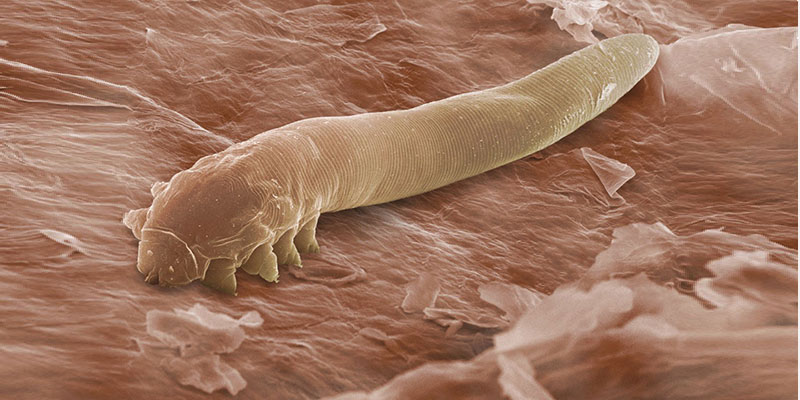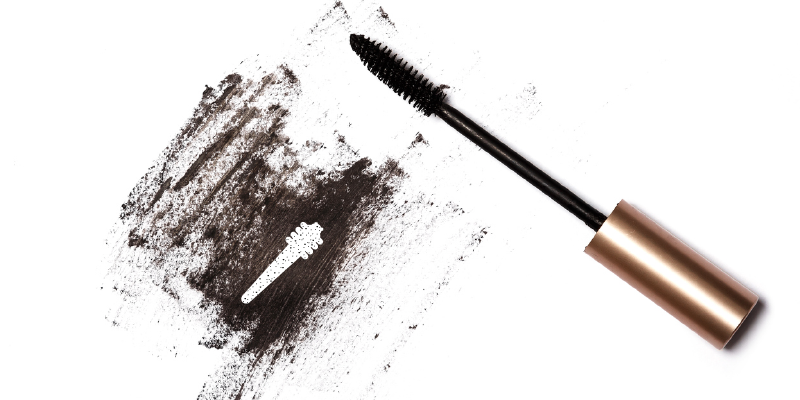Eyebrow mites are cousins to the spider. These tiny arachnids live and breed on your face and lay eggs in your hair follicles.
They’re known as Demodex mites (Demodex Folliculorum and Demodex Brevis). Sometimes, they are referred to as eyebrow or eyelash mites.
The fact is that these mites will live on any area of the human body that has hair, even the top of your head. However, they are most frequently associated with infesting the human face, where they cause issues including:
- Skin Irritation
- Redness
- Swelling
- Intense Itching
- Bacterial Infections
- Dry Eyes
- Rosacea
- Blepharitis
But what else do you need to know about these intrusive parasites? There is a lot to learn!
You may be surprised by where they can live, who gets them, and what you can do to get rid of them. Keep reading for all the answers to these questions and more.
Where Else Are Eyebrow Mites Found?

We already mentioned that Demodex mites can be found on the scalp, but did you know there are significant populations on the cheek too? They can’t be seen with the naked eye, only with a microscope, so they go unnoticed.
These mites can inhabit various areas of your body, including the:
- Eyebrows
- Eyelids
- Eyelashes
- Nose
- Cheeks
- Scalp
Do you rub your eyes frequently because they itch?
You may even feel like something is crawling on your skin, or sense an invisible creature moving through your eyelashes or eyebrows.
This is most likely to happen in the evening or when you first wake up in the morning. That’s because Demodex mites are most active at night.
The good news is, having Demodex mites isn’t a rare issue. Most people have mites living on them! It’s only when mite populations grow that they cause problems.
If you think you might have a Demodex mite problem, a dermatologist or eye care professional can confirm their presence by taking a skin scrape test.
More About Eyebrow Mites
These worm-like creatures are semi-transparent with little scales and short legs. The scales help them to attach to hair follicles as they eat skin cells and a substance called sebum.
Just when you are ready to get some rest at night, these face mites wake up and start to move around. Because they are nocturnal, they sleep in bright conditions.
But these creatures aren’t all bad. Demodex mites may have a symbiotic relationship with humans in the same way that good bacteria does.
When their populations are small, they help to remove dead skin cells and extra oils. However, in some people, eyebrow mites go wrong.
If the amount of mites becomes too much or the person they live on is allergic to them, people begin to suffer. And let’s face it, nobody wants mites living on their body!
The Lifecycle of Eyebrow Mites

The mites D. Folliculorum and D. Brevis are only able to live on humans (other species have their own mite species). They have a life cycle of about 2 weeks and live their entire lives between the hair follicles on your skin and oil glands (sebaceous glands).
By adulthood, they are less than ½ millimeter long. Adults only live for 4-6 days. During this time, they mate on the top of the hair follicle close to the skin’s surface. Females can deposit up to 24 eggs in the sebaceous glands of the follicle.
The hatchlings or larvae are born with 6 legs. In the week that it takes them to develop into adults, they grow their fourth pair.
Who Suffers Because of Mite Infestation?
People are not born with Demodex mites, but even newborn babies can get them from their mothers. We pass them on to each other, especially when we are close to one another. Not every single individual has mites, but they do exist on people in every region of the world.
As people get older, they are more likely to have mites on them. By the time you are 60, you have an 80%-100% chance of having Demodex living in your eyebrows or eyelashes.
Children have fewer mites because they produce less sebum than older people. People who wear a lot of makeup also seem to have more mites than those who do not.
When Demodex mites die, they expel all the waste in their bodies, which has built up over their entire life. A bacteria called bacillus is released with the waste.
When the mite population becomes too large they produce more waste and bacteria all at once which can trigger:
- Infection
- Immune system response*
- Inflammation
- Rosacea-like symptoms
- Blepharitis
- Acne outbreaks
*Studies have shows a connection between a Demodex outbreak and immunity issues.
It is important to realize that relief won’t be found without treating the symptoms and the cause. You need to relieve the skin or eye irritation caused by the eyebrow mites and get the population of mites under control too, or you will continue to suffer.
So let’s talk about the best way to reduce the amount of mites on your face.
Removing Demodex Mites
One of the most effective ways to control eyebrow mites and find relief is by adopting a routine that promotes good hygiene and kills the mites. Washing with average soap won’t help.
Demodex mites are resistant to a wide range of antiseptic solutions and other traditional treatments, such as cleansers, eye drops, and wipes. But tea tree oil extract is promising!
The bad news is, using pure tea tree oil or products like tea tree oil shampoo around your eyes is not safe or recommended. Tea tree essential oils or tea tree oil extract can cause nasty side effects like inflammation and cellular damage when used near the eyes.
But a few years ago, when scientists extracted various components from tea tree oil melaleuca, they discovered a more effective and safe way to help people suffering from Demodex mites. And it doesn’t cause injury or inflammation of the eyelids.

Cliradex towelettes are specifically designed for the eyes, lashes, and brows, and Cliradex Light foam cleanser can be used on the entire face. This natural eyelid and eyebrow cleanser is 100% vegan, gluten-free, and does not contain mineral oil. Best of all, Cliradex is specifically formulated to kill and clean away Demodex mites.
This article is not a substitute for medical diagnosis. If you believe that you have an eyebrow mite infestation, better known as Demodex mites, please speak with your primary health care physician or eye doctor.





